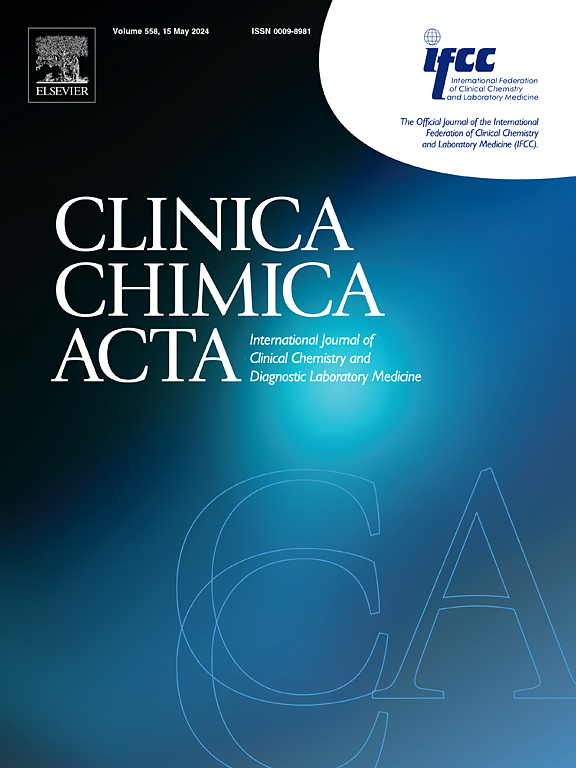动脉粥样硬化性心血管疾病中的脂蛋白(a)与蛋白转化酶枯草酶/kexin-9 型抑制剂。
IF 3.2
3区 医学
Q2 MEDICAL LABORATORY TECHNOLOGY
引用次数: 0
摘要
血浆脂蛋白(a)(Lp(a))水平过高会增加动脉粥样硬化性心血管疾病(ASCVD)患者的心血管风险。载脂蛋白(a)[apo(a)]是脂蛋白(a)的一种独特蛋白质成分,在动脉粥样硬化的发病机制中起着重要作用。他汀类药物是治疗急性心血管疾病的主要药物,可降低低密度脂蛋白胆固醇(LDL-C),但同时会升高血浆载脂蛋白(a)水平,导致残余心血管风险增加。而丙蛋白转化酶亚基酶/kexin-type 9(PCSK9)抑制剂是一类新型的降低低密度脂蛋白胆固醇药物,可有效降低血浆脂蛋白(a)水平,从而降低残余心血管风险。然而,PCSK9 抑制剂降低脂蛋白(a)水平的机制仍不清楚。此外,PCSK9 抑制剂还存在一些临床局限性。在此,我们系统回顾了有关脂蛋白(a)、PCSK9 抑制剂和 ASCVD 研究的过去、现在和前景。本文章由计算机程序翻译,如有差异,请以英文原文为准。
Lipoprotein(a) in atherosclerotic cardiovascular disease and proprotein convertase subtilisin/kexin-type 9 inhibitors
High plasma lipoprotein(a) (Lp(a)) levels increase the cardiovascular risk in populations with atherosclerotic cardiovascular disease (ASCVD). Apolipoprotein (a) [apo(a)], a unique protein component of Lp(a), plays an important role in the pathogenesis of atherosclerosis. Statins, the primary medication in managing ASCVD, lower low-density lipoprotein cholesterol (LDL-C) but concurrently elevate plasma Lp(a) levels, contributing to an increased residual cardiovascular risk. In turn, proprotein convertase subtilisin/kexin-type 9 (PCSK9) inhibitors, a novel class of LDL-C lowering drugs, effectively reduce plasma Lp(a) levels, which is believed to decrease residual cardiovascular risk. However, the mechanism by which PCSK9 inhibitors reduce Lp(a) levels remains unknown. In addition, there are some clinical limitations of PCSK9 inhibitors. Here, we systematically review the past, present, and prospects of studies pertaining to Lp(a), PCSK9 inhibitors, and ASCVD.
求助全文
通过发布文献求助,成功后即可免费获取论文全文。
去求助
来源期刊

Clinica Chimica Acta
医学-医学实验技术
CiteScore
10.10
自引率
2.00%
发文量
1268
审稿时长
23 days
期刊介绍:
The Official Journal of the International Federation of Clinical Chemistry and Laboratory Medicine (IFCC)
Clinica Chimica Acta is a high-quality journal which publishes original Research Communications in the field of clinical chemistry and laboratory medicine, defined as the diagnostic application of chemistry, biochemistry, immunochemistry, biochemical aspects of hematology, toxicology, and molecular biology to the study of human disease in body fluids and cells.
The objective of the journal is to publish novel information leading to a better understanding of biological mechanisms of human diseases, their prevention, diagnosis, and patient management. Reports of an applied clinical character are also welcome. Papers concerned with normal metabolic processes or with constituents of normal cells or body fluids, such as reports of experimental or clinical studies in animals, are only considered when they are clearly and directly relevant to human disease. Evaluation of commercial products have a low priority for publication, unless they are novel or represent a technological breakthrough. Studies dealing with effects of drugs and natural products and studies dealing with the redox status in various diseases are not within the journal''s scope. Development and evaluation of novel analytical methodologies where applicable to diagnostic clinical chemistry and laboratory medicine, including point-of-care testing, and topics on laboratory management and informatics will also be considered. Studies focused on emerging diagnostic technologies and (big) data analysis procedures including digitalization, mobile Health, and artificial Intelligence applied to Laboratory Medicine are also of interest.
 求助内容:
求助内容: 应助结果提醒方式:
应助结果提醒方式:


